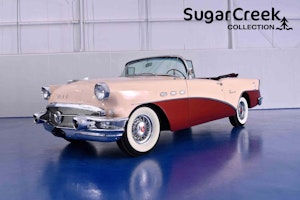Media | Articles
Before APTA, GM’s Canadian Pontiacs provided a bridge to the U.S.
Years before the 1965 Automotive Products Trade Agreement (APTA) greased the wheels of free trade between the U.S. and Canada, American carmakers were forced to get a little creative if they wanted to sell their products north of the border.
Prior to APTA, new cars imported from the U.S. were stiffly taxed in order to protect Canadian automakers and autoworkers. So American manufacturers avoided those restraints by building Canadian-market versions—in Canada—under different brand and model names. The vehicles were essentially U.S. models with slight differences in bodywork, engines, and detailing.
In 1955, for example, Canadian Pontiacs shared frames, engines, and drivetrains with Chevrolets, but they carried specific Pontiac-styled sheet metal to fit Chevy’s wheelbase, which was several inches shorter than that of an American Pontiac. Sharing engines was a significant policy change since GM divisions in the U.S. each built their own engines and almost never shared. Taking that into consideration, it can be a bit of shock for an American to lift the hood of a Canadian Pontiac and discover its seemingly tiny Chevrolet engine.

Still, Pontiac proved to be a cash cow for GM for 40 post-World War II years. Pontiac prices typically ran fractionally higher than corresponding Chevrolets, despite the fact that the cars cost virtually the same to build. However, buyers obviously felt they were getting more value and prestige with Pontiac than the lower-priced Chevy brand. Pontiac new-sales volume was often within 25 percent of Chevrolet’s numbers in Canada—a much higher proportion of the market than Pontiac held in the U.S.
Marketplace
Buy and sell classics with confidence
In 1962, the GM launched the Acadian brand in Canada. These cars were based on the new X-Body Chevrolet Chevy II built in Oshawa, Ontario, but with different trim, grille, and detailing. Overnight, Canadian Pontiac-Buick dealers became Pontiac-Buick-Acadian dealers. Acadian was a godsend to Canadian car dealers in an era when any compact priced right sold well.
In 1964, when Chevrolet introduced its all-new mid-sized Chevelle/Malibu cars, GM of Canada began offering an A-body Acadian Beaumont. By 1966, the Beaumont was spun off into another Canadian-specific marque no longer under Acadian, which continued with compact Chevy II-based cars only.

The 1964–65 Acadian Beaumont and 1966–69 Beaumont shared basic sheet metal and styling with the Chevelle and Malibu, as well as Chevrolet engines and chassis. They were sold alongside a few imported (and higher priced) Pontiac Tempests and LeMans, with lower-cost Beaumonts vastly out selling both.
The Beaumont had an SD trim level (for “Sport Deluxe”) instead of the SS (“Super Sport”) designation seen in the U.S. In 1965, a Beaumont SD equipped with a 350-horsepower Chevrolet 327-cid V-8 could be ordered for a mere $3,300 (Canadian), compared to the $3,982 (Canadian) price tag on the imported Pontiac GTO. SD buyers were also offered an optional 396-cid Chevrolet big-block engine. With a GTO instrument panel grafted into a Chevelle body, the Beaumont had a Pontiac look—from the driver’s seat anyway. A split front grille ensured that those in the know understood they weren’t looking at just another Chevrolet.

The 1965 Auto Pact took effect within months, but eliminating tariffs on cars and auto parts exchanged between Canada and the U.S. didn’t put an immediate end to GM’s popular Canadian Pontiacs. It wasn’t until the 1970 model year, in fact, that senior Pontiacs shared the exact wheelbase and wore the same sheet metal as their U.S. cousins. Even then, Canadian-specific names, trim variations, and the use of Chevrolet engines continued for the next two decades (although both Beaumont and Acadian were gone by the early ’70s).
Over the years, a few Canadian Pontiacs, Acadians, and Beaumonts have found their way into the U.S., where they often receive puzzled looks and inquiries from the uninitiated. They may look vaguely familiar to Americans, but for decades they provided an automotive bridge between Canada and the U.S.











Are Beaumonts and Acadians Pontiacs?
No, they were Chevrolets and marketed as such. A friend of mine in Canada had a 1964 Beaumont, which looked like a split-grill Chevelle. I still remember the looks that that car drew when we took it on a trip to Seattle in the mid 1970s.
In 1962, the GM launched the Acadian brand in Canada. These cars were based on the new Chevrolet Chevy II built in Oshawa, Ontario, but with different trim, grille, and detailing. Overnight, Canadian Pontiac-Buick dealers became Pontiac-Buick-Acadian dealers. Acadian was a godsend to Canadian car dealers in an era when any compact priced right sold well.
In 1964, when Chevrolet introduced its all-new mid-sized Chevelle/Malibu, GM of Canada began offering a Beaumont sold through Pontiac dealers.
The 1964–65 and 1966–69 Beaumont shared basic sheet metal and styling with the Chevelle and Malibu, as well as Chevrolet engines and chassis. They were sold alongside a few imported (and higher priced) Pontiac Tempests and LeMans, with lower-cost Beaumonts vastly out selling both.
The Beaumont had an SD trim level (for “Sport Deluxe”) instead of the SS (“Super Sport”) designation seen in the U.S. In 1965, a Beaumont SD equipped with a 350-horsepower Chevrolet 327-cid V-8 could be ordered for a mere $3,300 (Canadian), compared to the $3,982 (Canadian) price tag on the imported Pontiac GTO. SD buyers were also offered an optional 396-cid Chevrolet big-block engine. With a GTO instrument panel grafted into a Chevelle body, the Beaumont had a Pontiac look—from the driver’s seat anyway. A split front grille ensured that those in the know understood they weren’t looking at just another Chevrolet.